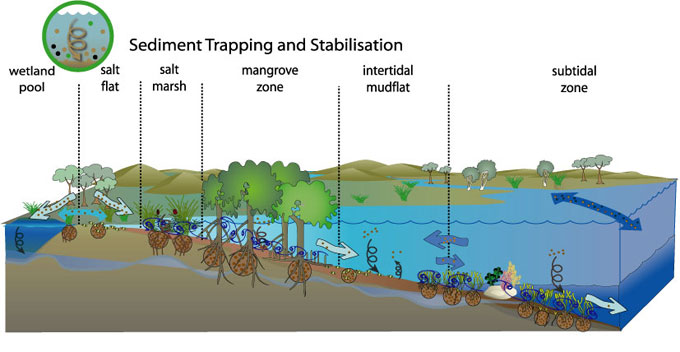
| Suspended sediment | Due to their filtering ability, water often tends to leave estuarine wetlands clearer, with less suspended sediment. However, large floods may temporarily reverse this situation (Wolanski, 1995; Furukawa et al, 1997) | ||
| Surface water flow from land brings suspended sediment into estuarine wetlands (Wolanski, 1995; Furukawa et al, 1997) | Sediment from rivers and the sea is mixed in estuaries (Noble et al, 2005) | ||
| Intertidal vegetation creates eddies and slows down water flow (Furukawa et al, 1997) | Tidal currents, waves and biological activity can ause sediment resuspension (Noble et al, 2005) | ||
| Surface water flow leaves the intertidal salt flat, salt marsh and mangrove zone after depositing some of its remaining sediment load (Wolanski, 1995; Furukawa, et al, 1997) | Incoming tides bring suspended sediment into intertidal areas (Furukawa and Wolanski, 1996; Noble et al, 2005) | ||
| Slower flowing water deposits sediment (Furukawa et al, 1997) | Outflowing tides with lower tidal energy carry a reduced amount of sediment to sub-tidal areas, partly due to sediment trapping by intertidal vegetation (Mazda, 1995; Furukawa and Wolanski, 1996; Noble et al, 2005) | ||
| Roots, rhizomes and algal mats bind and hold sediment (Wolanski, 1995; Miller et al, 1996; Butler and Jernakoff, 1999) |
References:
- Butler, A. & Jernakoff, P. 1999, Seagrass in Australia: Strategic Review and Development of an R&D Plan, CSIRO Publishing, Melbourne.
- Furukawa, K., Wolanski, E., Mueller, H., 1997, Currents and sediment transport in mangrove forests, Estuarine, Coastal and Shelf Science Vol. 44, no. 3, pp. 301-310.
- Furukawa, K., Wolanski, E., 1996, Sedimentation in Mangrove Forests, Mangroves and Salt Marshes, Volume 1(1) p3 – 10.
- Mazda, Y., Kanazawa, N., Wolanski, E., 1995, Tidal asymmetry in mangrove creeks, Hydrobiologia, Volume 295 (1-3) Pages 51 – 58.
- Miller, D. C., Geider, R.J., MacIntyre, H.L., 1996, Microphytobenthos: The Ecological Role of the “Secret Garden” of Unvegetated, Shallow-Water Marine Habitats. II. Role in Sediment Stability and Shallow-Water Food Webs, Estuaries, Vol. 19, No. 2, Part A: Selected Papers from the First Annual Marine and Estuarine Shallow Water Science and Management Conference (Jun., 1996), pp. 202-212.
- Noble, B., Bell, A., Verwey, P., Tilden, J., Fitzroy in focus: Coastal science for the Fitzroy region, Coastal CRC, Brisbane.
- Lynch, J.C., Meriwether, J.R., McKee, B.A., Vera-Herrara, F., Twilley, R.R., 1989, Recent accretion in mangrove ecosystems based on 137Cs and 210Pb, Estuaries 12, 284-299.
- Wolanski, E. Mazda, Y. and Ridd, P. 1992, Mangrove Hydrodynamics, Mangrove tropical ecosystems: coastal and estuarine studies, Ed. By A.I. Robertson and D.M. Alongi, p 43-62, American Geophysical Union, Washington D.C.
- Wolanski, E. 1995 Sediment transport in mangrove swamps, Hydrobiologia, Volume 295 (1-3) 51 – 58.


